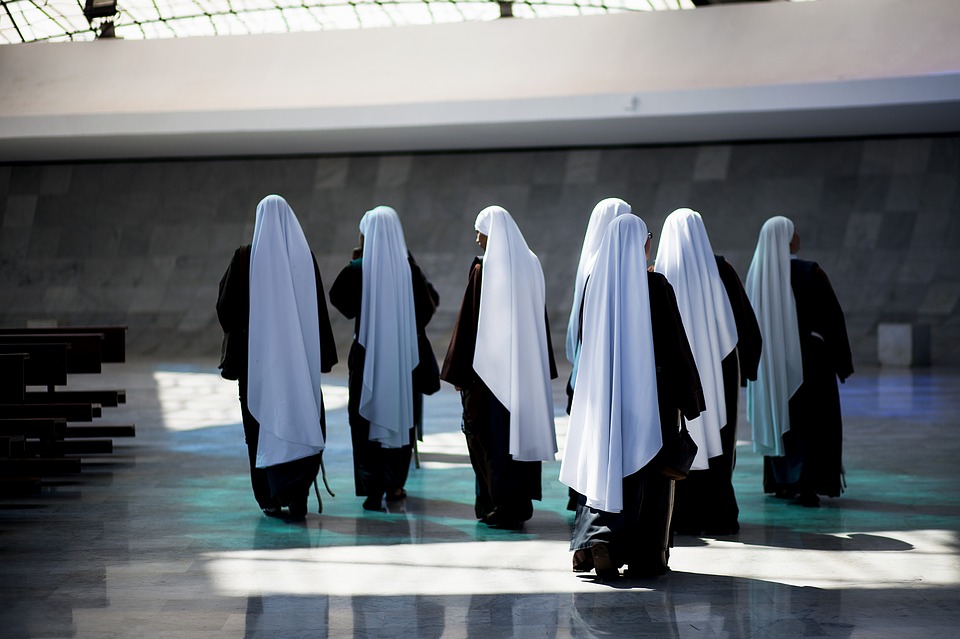
In his book The World Beyond Your Head Matthew Crawford uses the idea of a jig to explain how a carpenter might go about accomplishing a task more quickly and efficiently. Jigs are a kind of hack, a method for doing a task when external circumstance forces one to find new ways of doing familiar work.
I thought of Crawford’s book several times while reading Eve Fairbanks’ fascinating new longform piece in the HuffPo that is trying to understand why a growing number of young women are considering becoming nuns. The piece begins with a condensed summary of the tired and discredited secularization theory that expects societies to become more secular as they become more modern.
Given that theory, the author wonders, why are so many young people not only adopting more conservative religious beliefs, but even considering various forms of consecrated monastic life?
Of course, the answer is obvious. Indeed, if any media outlet should know the answer intuitively you would think it’d be the magazine that brought us a long-form investigation into suicide prevention and explained why millennials are screwed.
But, alas, they’re stumped.
Here is the answer:

In other words, when you create a society designed to produce alienated people, don’t be surprised when those people take radical action to find belonging, meaning, and significance. Indeed, if we are already pushing people toward a sad, secular form of monastic life why would we be surprised when they opt instead for the real thing?
Thankfully, the piece eventually gets there—and in a surprisingly self-aware way:
We are a thing that is wounded, American society. People raised for the new millennium were to be a kind of final proof that democracy and American society was, indeed, the greatest that ever could be made, now that primitive superstitions had been cleared, tech and science and finance reigned, major political threats had fallen and our hegemony seemed complete. We were, and shakily remain, utopian in ways I would laugh at if I hadn’t bought into them, too. More than half of millennials still tell pollsters they believe they’re going to be millionaires. Most of us expected to achieve idyllic marriages, even though so many of our parents had divorced. We were taught that anything you hoped for could be achieved with the right planning, that life is a series of hacks: fabulous tricks, but ones that have a reliable code for how to repeat them.
Of course, none of this was true. The tech bubble burst. There was 9/11 and the financial crisis and the surprise election of a reality-TV tycoon as president—all things that loosened our faith in the world’s goodness and in our comprehension of and control over things.
Given such a world, of course we see more young people turning to the structures of religious life as a means of escape from the anomie that defines their existence.
Many young people, particularly high-achieving organization kids, actually want structure for their life. They don’t want the freedom that has been offered to them by parents, schools, and the promises of mass media. Matt Schmitz gets at the problem well in this post:
Among my peers there is a vague, floating sense of dislocation and disinheritance. They have been schooled in rebellion but have nothing to rebel against. This is the cause, I think, of the enthusiasm many young people show for ritual, ceremony, and all things traditional. Having been raised in a culture of unending pseudo-spontaneity, they have had time to count its costs. They prefer more rigid forms.
These rigid forms are a jig for mimicking stability and safety. Their adoption is a means for a person to stake out an identity that already exists, something that isn’t created from scratch and doesn’t require extensive personal work.
The Catholics are not the only ones pursuing such things, of course.1 There is a growing Anglican presence in many places that have traditionally been white evangelical hubs—Colorado Springs, Nashville, and the western suburbs of Chicago all have growing Anglican presences largely populated by Generation X and Millennials who grew up evangelical and found the vapidity of much evangelical liturgy to be tiresome and lacking in life. The stricter practices of an Anglo-Catholic mass or even simply adopting a lectionary, which assigns your scripture readings and the ordering of the service, is a similar sort of liturgical jig for this group.
Even in the PCA you can find churches with fairly traditional liturgies. My home congregation sings hymns with an organ, has weekly confession of sin (with kneeling), frequently sings the “Gloria Patri” and “Agnus Dei” and one of the pastors frequently uses the Te Deum as part of his prayer during the liturgy. We also have weekly communion and a baptismal font in the center of the worship space.
None of this is wrong, of course. Indeed, I think much of it is very right!2 Speaking personally I far prefer such traditional liturgies to whatever nonsensical thing is currently trending in the land of megachurches and video preaching. But in terms of one’s personal piety, the structure can easily become and remain a jig—and you yourself remain distant from the personalized practice of confession and mortification of sin, acts of mercy, Bible study, and prayer.
This is where Crawford’s concept of the jig comes into play. Just as the use of a jig does not make one a carpenter, so the choice to become a nun does not make one stable, mature, content, and so on. It might make the path toward maturity a bit more clear. Certainly it can remove a great many obstacles to maturity. But the ability to use a jig does not make one competent at the work. Indeed, if circumstances change and the jig stops working, a person who relies on jigs will suddenly be no better off than any other untrained person. And this dependence on a jig can be a problem. The work of spiritual maturation cannot be automated or outsourced to rituals, however good those rituals might be in many ways.
Jigs are useful. But the process can never stop at the jig. The hard work of maturity beckons us to enter the Christian life more deeply. The liturgies and daily practices of a more traditional practice of the faith are great aids. But they are aids, not the thing itself.
Footnotes
Jake Meador is the editor-in-chief of Mere Orthodoxy. He is a 2010 graduate of the University of Nebraska-Lincoln where he studied English and History. He lives in Lincoln, NE with his wife Joie, their daughter Davy Joy, and sons Wendell, Austin, and Ambrose. Jake's writing has appeared in The Atlantic, Commonweal, Christianity Today, Fare Forward, the University Bookman, Books & Culture, First Things, National Review, Front Porch Republic, and The Run of Play and he has written or contributed to several books, including "In Search of the Common Good," "What Are Christians For?" (both with InterVarsity Press), "A Protestant Christendom?" (with Davenant Press), and "Telling the Stories Right" (with the Front Porch Republic Press).